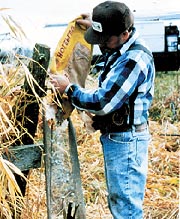

Ideally, all well abandonments should restore the subsurface integrity to conditions equal to or better than before the borehole was drilled. Wells that are not properly abandoned at sites where contamination exists can act as a conduit for contamination to readily flow into zones previously uncontaminated. Subsurface contamination can continue undetected for many years and be very difficult to correct, even if the leaking well can be located.
Contamination can travel along the outside of the casing downward to the screened zone if the annular space is not sealed, or contamination could enter through a hole or crack in the casing at the water table and drain into the casing and downward to the screened zone.
If the annular space outside of the well casing is known to be sealed with cement or bentonite clay across all confining and semi-confining beds, then the well may abandoned by filling the inside of the casing with cement and/or a bentonite clay slurry.
If the integrity of the annular seal of the well is in doubt, the casing should be over-drilled and pulled out completely. This normally is performed using a hollow-stem auger or threaded steel pipe with teeth on the bottom of the casing, which is spun over the casing to be pulled. Circulating mud while the casing is being spun will help remove the material from around the casing. Once the casing is removed, the mudded hole can be sealed by pumping cement to the bottom through a tremie pipe until the cement reaches land surfaces.
Abandoning a well by simply filling the inside of a casing that has not been properly sealed could overlook a conduit leaking along the outside of the casing for a long time. Although the over-drilling is much more costly, the method is much more effective in protecting the ground water resources.
Well abandonment procedures should be documented and properly filed or included in a report for future reference by others. The exact location should be documented so that the well can be relocated if it is difficult to find. The location should also be surveyed or its location established using a Global Positioning System (GPS).
Report Abusive Comment